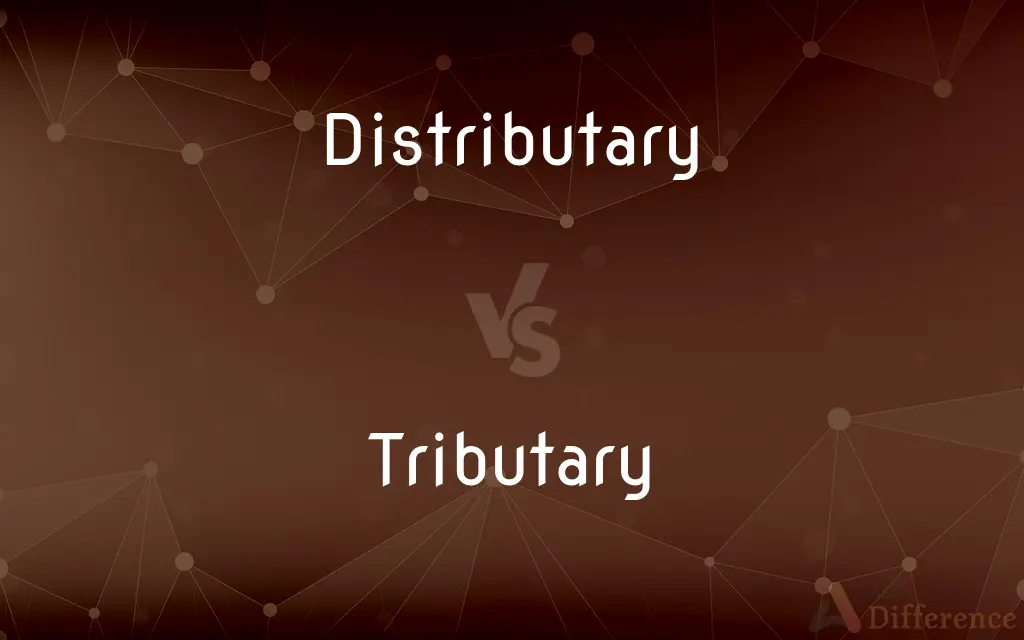Distributary vs. Tributary — What's the Difference?
By Tayyaba Rehman — Updated on September 24, 2023
Distributary is a river branch flowing away from the main stream; Tributary is a river or stream flowing into a larger one.

Difference Between Distributary and Tributary
Table of Contents
ADVERTISEMENT
Key Differences
A Distributary is a section of a river that branches off and flows away from the main river channel. It typically occurs in a river’s delta, where the river's flow meets a body of water like a lake or the ocean, and sediment deposition causes the river to split into multiple channels. Distributaries play a crucial role in distributing water and sediments across the delta, contributing to its growth and shaping the landscape.
In contrast, a Tributary is a smaller stream or river that flows into a larger one, contributing to its flow. Tributaries are essential components of a river system as they collect and channel water from the surrounding landscape into the main river, increasing its water volume and bringing dissolved and suspended materials. The presence of multiple tributaries usually signifies a well-drained watershed and is indicative of the river’s catchment area.
Distributaries, by diverting water away from the main channel, can lead to the formation of new water bodies and can significantly alter the hydrology and ecology of a region. They are integral in shaping deltaic environments and create diverse habitats, supporting a variety of flora and fauna. Distributaries are usually characterized by lower flow velocity and sediment-laden waters, which encourage sediment deposition and land formation.
Conversely, Tributaries serve to aggregate water and materials, channeling them towards the main river. The confluence of a tributary and the main river can be a dynamic area with mixing of waters and deposition of sediments, often affecting the local ecology and geomorphology. Tributaries can originate from various sources like springs, glaciers, or runoff and can vary widely in size, flow characteristics, and composition.
To summarize, while distributaries are river branches that divert water away from the main stream, usually in delta regions, tributaries are streams or rivers that contribute water to the main river, enhancing its flow and the transport of materials. Both distributaries and tributaries are essential elements of riverine systems, impacting the landscape, ecology, and hydrology of their respective regions.
ADVERTISEMENT
Comparison Chart
Definition
Branch of a river flowing away from main stream
Stream or river flowing into a larger one
Function
Distributes water and sediments in delta regions
Contributes water and materials to main river
Location
Typically found in delta regions
Found throughout river systems
Impact on Main River
Decreases water volume in main river
Increases water volume in main river
Hydrological Role
Alters hydrology and creates new habitats
Enhances river flow and affects local ecology
Compare with Definitions
Distributary
A section of a waterway splitting from the main river channel and not rejoining it.
A distributary may alter the water flow dynamics of the entire river system.
Tributary
A river or stream flowing into a larger river or lake.
The tributary supplies additional water to the main river, increasing its volume.
Distributary
A watercourse diverting water from the main river, typically in a delta.
The distributary carries nutrient-rich water, fostering abundant life in its path.
Tributary
Stream or river aggregating water and materials to the main river system.
Numerous tributaries join the river, enriching it with sediments and nutrients.
Distributary
River branch primarily found in delta regions, shaping the landscape by depositing sediments.
The extensive distributary network has created a complex and fertile delta region.
Tributary
A contributing stream that increases the water volume and transport capacity of the main river.
This large tributary significantly impacts the hydrology of the entire river basin.
Distributary
A natural watercourse contributing to land formation by diverting river flow.
Over time, the distributary has created new islands within the delta.
Tributary
A smaller watercourse contributing flow to a larger one.
This tributary originates in the mountains and brings cold, clear water to the river.
Distributary
A distributary, or a distributary channel, is a stream that branches off and flows away from a main stream channel. Distributaries are a common feature of river deltas.
Tributary
Water body enhancing river flow by channeling water from the surrounding landscape.
The extensive network of tributaries plays a crucial role in maintaining the river’s flow.
Distributary
A branch of a river that flows away from the main stream.
Tributary
A tributary or affluent is a stream or river that flows into a larger stream or main stem (or parent) river or a lake. A tributary does not flow directly into a sea or ocean.
Distributary
That distributes.
Tributary
A stream that flows into a larger stream or other body of water.
Distributary
(hydrology) A stream of water (either natural or artificial) that branches off and flows away from a main stream channel.
Tributary
A ruler or nation that pays tribute.
Distributary
Tending to distribute or be distributed; that distributes; distributive.
Tributary
Making additions or yielding supplies; contributory.
Distributary
A branch of a river that flows away from the main stream and does not rejoin it
Tributary
Paid in tribute.
Tributary
Paying tribute
A tributary colony.
Tributary
(hydrology) A natural water stream that flows into a larger river or other body of water.
Tributary
(anatomy) A vein which drains into a another vein.
The great saphenous vein is a tributary of the femoral vein.
Tributary
A nation, state, or other entity that pays tribute.
Tributary
Related to the paying of tribute.
Tributary
Subordinate; inferior
Tributary
Yielding supplies of any kind; serving to form or make up, a greater object of the same kind, as a part, branch, etc.; contributing.
The Ohio has many tributary streams, and is itself tributary to the Mississippi.
Tributary
Paying tribute to another, either from compulsion, as an acknowledgment of submission, or to secure protection, or for the purpose of purchasing peace.
[Julius] unto Rome made them tributary.
Tributary
Hence, subject; subordinate; inferior.
He to grace his tributary gods.
Tributary
Paid in tribute.
Tributary
Yielding supplies of any kind; serving to form or make up, a greater object of the same kind, as a part, branch, etc.; contributing; as, the Ohio has many tributary streams, and is itself tributary to the Mississippi.
Tributary
A ruler or state that pays tribute, or a stated sum, to a conquering power, for the purpose of securing peace and protection, or as an acknowledgment of submission, or for the purchase of security.
Tributary
A stream or river flowing into a larger river or into a lake; an affluent.
Tributary
A branch that flows into the main stream
Tributary
Of a stream; flowing into a larger stream
Tributary
Paying tribute;
A tributary colony
Tributary
Tending to bring about; being partly responsible for;
Working conditions are not conducive to productivity
The seaport was a contributing factor in the growth of the city
A contributory factor
Common Curiosities
Can a Distributary rejoin the main river downstream?
Typically no, distributaries usually do not rejoin the main stream.
Do Tributaries only carry freshwater?
Primarily yes, as they are part of river systems which are freshwater bodies.
Are Distributaries common in all river systems?
No, distributaries primarily occur in delta regions where a river meets another body of water.
Does the presence of Distributaries indicate a river’s delta region?
Yes, distributaries are characteristic of delta regions where rivers meet another body of water.
Do Tributaries always increase the water level of the main river?
Generally, yes, as they contribute additional water, but the extent of increase depends on the tributary’s flow.
Can Distributaries be artificially created for irrigation purposes?
Yes, humans can create distributaries to divert river water for irrigation.
Is every small stream that joins a river considered a Tributary?
Yes, any stream or river, regardless of size, that flows into a larger one is a tributary.
Is the formation of a Distributary a dynamic and ongoing process?
Yes, distributary formation is dynamic and evolves with changes in sediment deposition and water flow.
Can human activities influence the formation of Distributaries?
Yes, human interventions like damming can alter river flow and potentially lead to distributary formation.
Are Tributaries critical for maintaining a river’s ecosystem?
Absolutely, they bring in water, nutrients, and sediments essential for the river’s health.
Is the point where a Tributary joins the main river called a confluence?
Yes, the junction of a tributary and the main river is known as a confluence.
Are Distributaries important for biodiversity in delta regions?
Absolutely, they create diverse habitats and are crucial for sustaining varied flora and fauna in deltas.
Can the formation of Distributaries lead to land loss in some areas?
Yes, as they divert water from the main river, some areas may experience reduced sediment deposition and erosion.
Can Tributaries have their own Tributaries?
Yes, tributaries can have their own smaller tributaries contributing to their flow.
Does the presence of numerous Tributaries indicate a well-drained watershed?
Yes, multiple tributaries typically signify efficient drainage of the surrounding landscape.
Share Your Discovery

Previous Comparison
Nectar vs. Juice
Next Comparison
Novation vs. AssignmentAuthor Spotlight
Written by
Tayyaba RehmanTayyaba Rehman is a distinguished writer, currently serving as a primary contributor to askdifference.com. As a researcher in semantics and etymology, Tayyaba's passion for the complexity of languages and their distinctions has found a perfect home on the platform. Tayyaba delves into the intricacies of language, distinguishing between commonly confused words and phrases, thereby providing clarity for readers worldwide.
















































